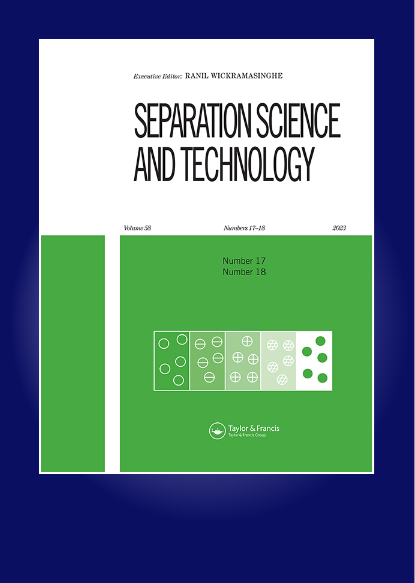Two new ammonium-based poly(ionic liquid)s for breaking water-in-crude oil emulsions
IF 2.3
4区 工程技术
Q3 CHEMISTRY, MULTIDISCIPLINARY
引用次数: 0
Abstract
ABSTRACTTwo new poly(ionic liquid)s (PILs) were synthesized, characterized, and applied in breaking water-in-oil (W/O) emulsions. For that, tetraethylene glycol (TG) was treated with thionyl chloride, obtaining dialkyl chloride (TC). TC was reacted with diamines 1,5-diaminopentane (AP) and 1,11-diaminoundecane (AU), forming the corresponding polyamines, TC-AP and TC-AU. Following this, TC-AP and TC-AU were quaternized with acetic acid (AA), producing poly(ionic liquid)s (PILs), TCAP-PIL, and TCAU-PIL, respectively. Chemical structures, thermal stability, surface activity, aggregation size, and zeta potential measurements were investigated using several techniques. In addition, their performance in breaking (PB) W/O emulsions in different ratios was investigated. TCAP-PIL and TCAU-PIL exhibited high PB at all ratios, while their performance improved as the crude oil ratio decreased. Moreover, TCAU-PIL showed higher PB than TCAP-PIL, which may be linked to the increased hydrophobicity of TCAU-PIL due to increased methylene units in the diamine chain compared to TCAP-PIL.KEYWORDS: Poly(ionic liquid)sdemulsificationwater-in-crude oil emulsion AcknowledgmentsThe authors acknowledge the financial support through Researchers Supporting Project number (RSPD2023R688), King Saud University, Riyadh, Saudi Arabia.Disclosure statementThe authors declare that they have no known competing financial interests or personal relationships that could have appeared to influence the work reported in this paper.Additional informationFundingThe authors acknowledge the financial support through Research Supporting Project number (RSPD2023R688), King Saud University, Riyadh, Saudi Arabia.两种新型氨基聚离子液体用于破乳原油含水
摘要合成了两种新型聚离子液体(pil),对其进行了表征,并将其应用于油包水(W/O)乳剂的破乳。为此,用亚硫酰氯处理四甘醇(TG),得到二烷基氯(TC)。TC与1,5-二氨基戊烷(AP)和1,11-二氨基癸烷(AU)反应,生成相应的多胺TC-AP和TC-AU。然后,将TC-AP和TC-AU与乙酸(AA)季铵化,分别制备聚离子液体(PILs)、TCAP-PIL和tcu - pil。化学结构、热稳定性、表面活性、聚集大小和zeta电位测量使用了几种技术。此外,还研究了它们在不同配比下破乳(PB) W/O乳液的性能。TCAP-PIL和tcu - pil在各配比下均表现出较高的PB,随着原油配比的降低,其性能有所提高。此外,tcu - pil比TCAP-PIL表现出更高的PB,这可能与tcu - pil比TCAP-PIL增加了二胺链上的亚甲基单位而增加了疏水性有关。作者感谢沙特阿拉伯利雅得沙特国王大学科研人员支持项目(RSPD2023R688)的资金支持。披露声明作者声明,他们没有已知的竞争经济利益或个人关系,可能会影响本文所报道的工作。作者通过沙特阿拉伯利雅得沙特国王大学的研究支持项目号(RSPD2023R688)表示感谢。
本文章由计算机程序翻译,如有差异,请以英文原文为准。
求助全文
约1分钟内获得全文
求助全文
来源期刊

Separation Science and Technology
工程技术-工程:化工
CiteScore
6.10
自引率
3.60%
发文量
131
审稿时长
5.7 months
期刊介绍:
This international journal deals with fundamental and applied aspects of separation processes related to a number of fields. A wide range of topics are covered in the journal including adsorption, membranes, extraction, distillation, absorption, centrifugation, crystallization, precipitation, reactive separations, hybrid processes, continuous separations, carbon capture, flocculation and magnetic separations. The journal focuses on state of the art preparative separations and theoretical contributions to the field of separation science. Applications include environmental, energy, water, and biotechnology. The journal does not publish analytical separation papers unless they contain new fundamental contributions to the field of separation science.
 求助内容:
求助内容: 应助结果提醒方式:
应助结果提醒方式:


